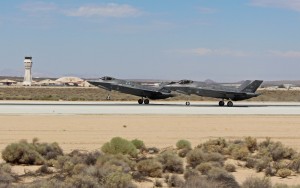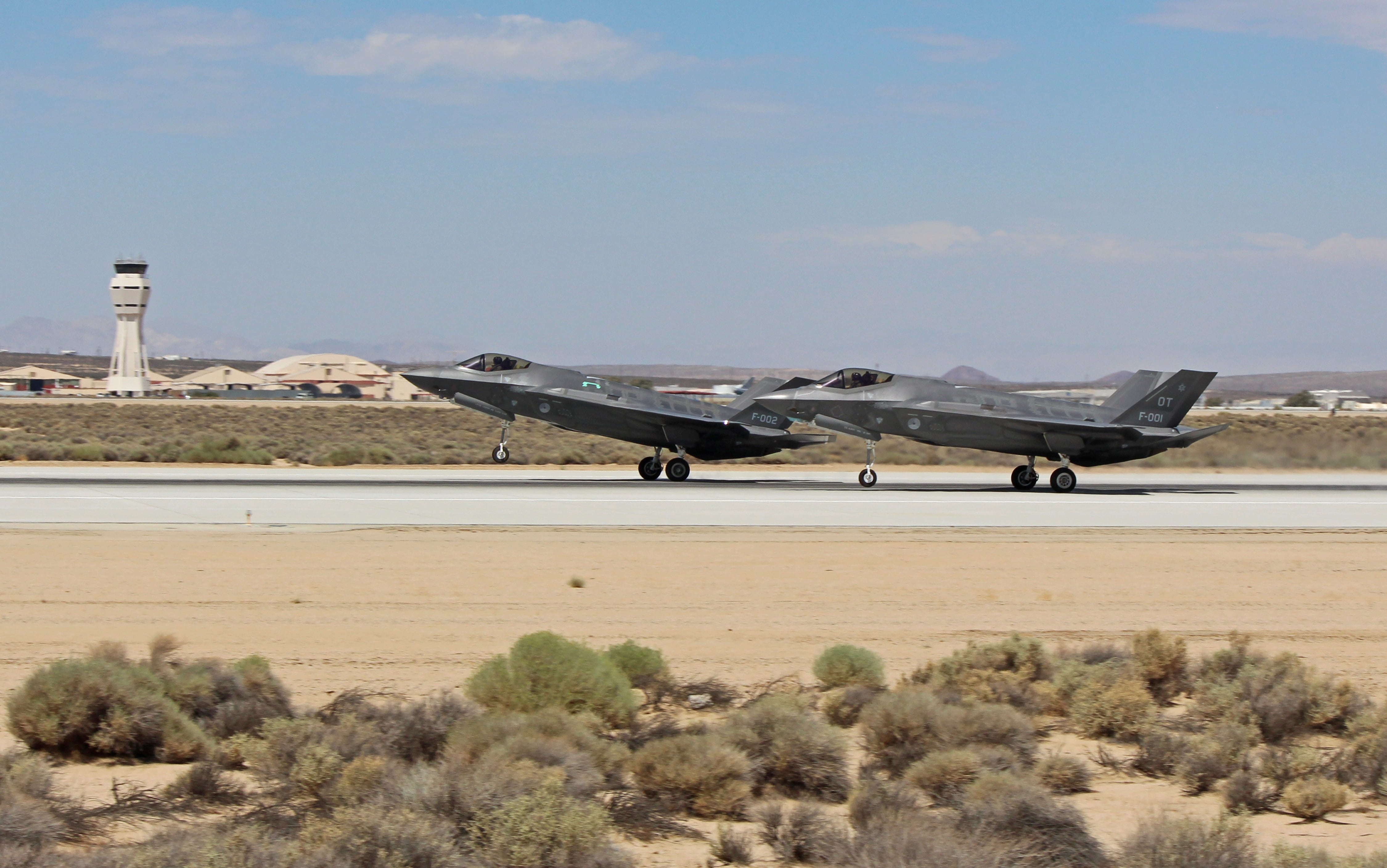2016-03-05
According to an article published by Edwards AFB on 2/24/2016:
A Dutch F-35A Lightning II will touch down on home soil for the first time for environmental compatibility trials this spring according to a Royal Netherlands Air Force release.

The F-35 will conduct several low-altitude circuits, take-offs, and landings at both Leeuwarden Air Base and Volkel Air Base, where the aircraft will eventually be based.
The RNLAF plans to replace its legacy F-16A/B fleet with a minimum of 37 F-35s, split between the two bases.
An F-16 will accompany the F-35 during the trials in May or June, to provide comparison data on the level of noise generated by the two aircraft, and its possible impact on nearby communities, according to the release.
The first Dutch F-35 unit, Number 323 Squadron, is currently undertaking operational test and evaluation at Edwards AFB, Calif. Airfield trials will begin in earnest next year ahead of the aircraft permanent relocation to the Netherlands in 2019, according to the RNLAF.
And in a recent piece published about the Dutch F-35 testers, a number of key points were highlighted:
The future of Dutch air warfare is shaped in all of the vast airspace around Edwards Air Force Base, California. The two tools of the trade have clocked up over 500 flight hours since first delivery in 2013.
They are two stealthy and somewhat secretive F-35A Lightning II fighter jets, flown and tested by Royal Netherlands Air Force (RNLAF) 323 squadron. Edwards is their home away from home and will be so for some time to come. Testing done right takes time.
Edwards is the ‘home of the right stuff’ and the perfect place for Operational Test and Evaluation (OT&E) of any fighter aircraft let alone the Lockheed Martin F-35 Lightning II, the fifth generation fighter aircraft that sparked so much debate over the last decade. ….
“And we are moving along nicely”, says Marten Hendriksma, chief of RNLAF fighter operations. “Our four pilots are now involved in weapons employment following the successful systems integration tests in 2015.
Those tests proved two F-35s can work jointly using both aircraft’s sensors, AN/APG-81active electronically scanned array (AESA) radar and Multifunction Advanced Data Link (MADL), and share this information with accompanying F-16s using Link-16.”
The goal is of course to prepare the F-35 and its pilots for any future threats. Hendriksma: “The jet is capable of seeing and engaging targets from great distances, or guiding accompanying fighters towards those targets using the data link system.
An F-35 pilot can selectively provide other combat pilots with the chunks of information those pilots need to enhance their situational awareness. It really is so much more than a bomb truck.”
It is also why system integration with F-16s is important, because they represent all of the fourth generation fighter jets that will remain active in international conflicts for decades to come.
“It’s vital that the F-35 shares its information with other allied combat jets, also such as aircraft as the Rafale and Typhoon. For the guys who fly those jets, it’s brilliant.
The F-35 is a force multiplier and an eye in the sky, with the added bonus that it can fly directly over the battlefield and engage targets itself as needed, unlike an AWACS that usually stays away over more friendly territory…..”
“The F-35 will have a large advantage going into the visual arena against fourth generation or aircraft like the Su-35, due to its advanced sensors, stealth and datalink capability and resulting increased situational awareness.
We have already seen this during testing at Edwards”, says ‘Gladys’, one of the RNLAF pilots at Edwards.
The visual fight will most likely already be decided before the adversary knows it’s in a dogfight, continues Gladys. “Even so, slow-speed and high angle-of-attack performance is much better than many fourth generation fighters like the F-16. High angle of attack testing has been an eye-opener for previous F-16 pilots, who are not used to very good slow speed performance.
Straight line acceleration is also much better.
At higher speeds, the F-16 has the sustained turning advantage (as it does over many aircraft like the F-18), but only when fighting in training configurations without any missiles or bombs. When flying in combat configs, even the high speeds sustained fight becomes much closer.”
Each day at Edwards, the Dutch better get to know their two silver-grey and somewhat sinister looking aircraft, unassumingly known as F-001 and F-002. Modifications are an ongoing thing.
A major upgrade in 2016 and 2017 is the installment and testing of the latest and ‘combat-ready’ Block-3F configuration instead of the current Block-2B, which is the same software found in the United States Marine Corps (USMC) F-35B that reached Initital Operational Capability (IOC) in July last year.
“Right now, we are successful in reaching 60 percent serviceability whereas we aim at 70 percent. That is still considerably better than the F-16 in the early stage of its career,” says Erik Rab, who supports Dutch testing from the F-35 Joint Program Office in Washington, DC….
Liaisons are also in place with the Italian Air Force, who plan to fly the first Italian-made F-35 across the Atlantic to the US in February, using one of their Boeing KC-767s for air-to-air refueling (AAR).
“It’s no secret that we are planning to fly an F-35 to the Netherlands later this year, so any experience the Italians gain is also valuable to us.
Our jets are yet to refuel from our own KDC-10 tanker and we’ll start testing and validating AAR soon in preparation for our own Transatlantic flight”, says Rab.
“We’ve flown 3 to 4 hour-missions already with refueling by US tankers.”
If all goes to plan, F-001 should arrive in the Netherlands some time in May, ahead of the RNLAF airshow at Leeuwarden.
“The test schedule at Edwards is tight and nothing is certain yet”, says Marten Hendriksma. “The priority is to familiarize those living around Dutch airbases with the F-35 and its noise levels, as promised by the Minister of Defence.
For the rest of the article, see the following:
http://airheadsfly.com/2016/01/26/dutch-lightning-testers/


